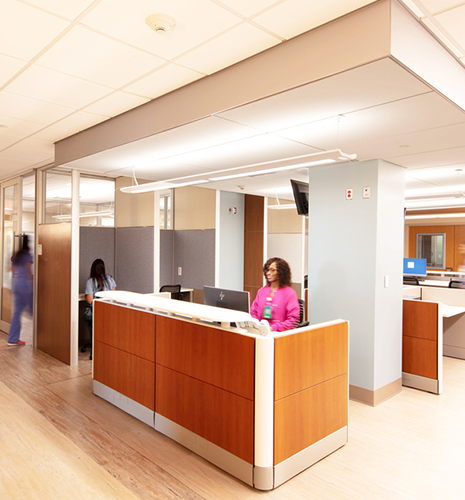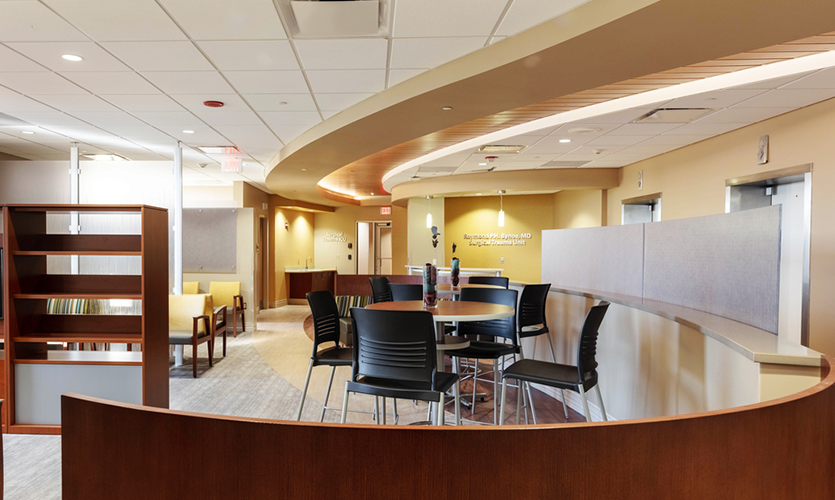Dr. Raymond P.H. Bynoe Surgical Trauma Intensive Care Unit (STICU)
Prisma Health Richland

Projects > Dr. Raymond P.H. Bynoe Surgical Trauma Intensive Care Unit (STICU)
Prisma Health Richland
The new STICU is Phase I of an overall $38 million ICU Master Plan for Prisma Health Richland. The Richland Hospital is the tertiary healthcare facility for the Midlands region and is the only Level 1 Trauma Center in the area. Because of their traumas, patients treated in this unit are the most vulnerable to detrimental environmental effects. Great care was taken to create a unit that would environmentally support patients, staff, and their families – focusing on infection control, therapeutic lighting, expanded room size, equipment placement; and coordination and staff views of and access to their patients.
A highlight of the design is the use of “tunable lighting” as a therapeutic treatment and environmental enhancement for patients and staff. Tunable lighting, which uses LED lighting to mimic the natural progression of daylight, is utilized throughout the 18-bed unit. Research has begun to show that this type of lighting may help patients heal faster, decrease delirium, and have less long-term negative mental distress from being in the hospital. This type of lighting has also been shown to increase staff alertness, lessen fatigue, and limit health issues associated with night shift work.
Another feature is the use of disposal rooms in lieu of patient toilets. As these patients are typically too sick to move out of their beds, the unit utilizes a shared disposal room between each pair of patient rooms, giving staff a close disposal location that decreases the infection issues associated with the transport of sanitary waste. In addition, each disposal room is equipped with a special light that is illuminated when the room is not occupied, that has been tested to kill 99.9% of germs and bacteria.


Have a question regarding our services? Need assistance with an upcoming project? Send us an email. We look forward to hearing from you and will follow up soon.
© SSOE GROUP 1948-2025
Legal | Privacy Policy | CA Privacy Policy | Cookie Policy
Website designed and developed by
Raincastle Communications, Inc.

 Freestanding Emergency Care Center
Freestanding Emergency Care CenterAutodesk Construction Cloud (ACC) is SSOE’s enterprise-wide project delivery platform. We partner with the Autodesk Product team and have research access. Use of the AI Assistant allows our design teams, owners, and general contractors the ability to query the project specifications for quality, answers, and more rapid responses to RFIs, submittals, or issues.
SSOE has developed a proof-of-concept to use an AI Agent to act as a Master Engineer and Architect trained in SSOE’s processes, best-known-methods, and trainings. Our data structure is being remodeled to enable better use of our proprietary knowledge to train the agent on the ‘SSOE way’.
SSOE is actively piloting AI Chat large language models (LLMs) or copilots that use Natural Language Processing (NLP) to streamline both design and development tasks, transforming how our teams interact with software and each other.
By integrating chat LLM engines into platforms like Revit, we’re enabling users to prompt complex actions using simple, conversational commands. In Revit, this means automating tasks such as modeling elements, cleaning up parameter data, managing annotations and dimensions, and organizing sheets—without writing scripts. These automations and quality prompts can be shared across project teams, accelerating workflows and reducing manual effort.
Similarly, our internal Software Development Community is leveraging GitHub Copilot to expedite coding tasks. Developers can generate and refine code using NLP prompts, tapping into GitHub’s extensive Repo to move faster from concept to implementation.
Together, these tools represent a shift from traditional, expert-driven scripting to intuitive, AI-assisted automation, unlocking new levels of efficiency and scalability across our projects.
We helped our client visualize and optimize façade design for occupant comfort—long before breaking ground through the use of the Autodesk Forma tool. It allows the designer to rapidly experiment with the building’s geometry and façade design to promote sustainability, prioritizing quality of spaces and comfort for end uses, especially in extreme climates (daylighting and microclimate analysis tools) at the project’s exact geographic location, using location-specific environmental data.
Discover how SSOE is using Autodesk Forma to improve sustainability outcomes for industrial projects: SSOE Group: Improving sustainability outcomes for industrial projects with Autodesk Forma.
SSOE is utilizing Microsoft Copilot Edge and M365 to significantly enhance work efficiency and accuracy across various departments. Copilot is accessible to all staff after training. Key areas of application include using it as a writing assistant, for idea generation, document summarization and generation, research assistant, excel assistant, programming code assistant, language translations, product comparison and data analysis. Use of Copilot has become part of the everyday life of SSOE employees who have identified key ways it can help them become more efficient with their daily tasks as well as more accurate in their deliverables.
Today, 100% of SSOE employees have taken the voluntary training and have access to Copilot Edge, achieving early our October 1, 2025 goal.
We found ourselves in need of a more robust tool to enhance resource forecasting and staff assignment capabilities. Instead of waiting for the perfect tool, we’re building it. SSOE’s in-house technology team has developed and piloted a tool that aims to forecast optimal staff mix and duration for new projects against existing workload to better understand capacity and manage resources efficiently. Additionally, the tool will allow teams to identify gaps to optimal staff mix.